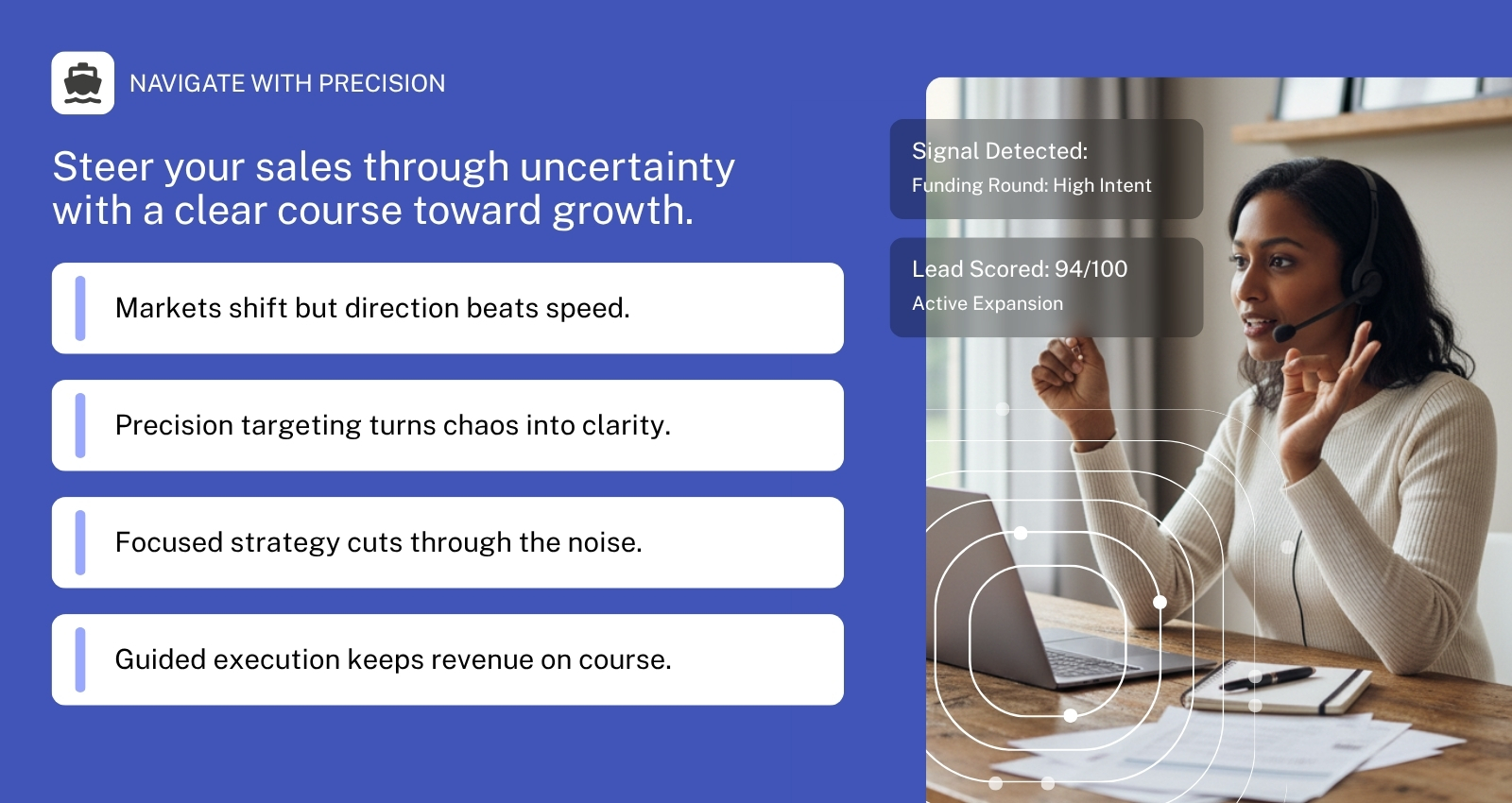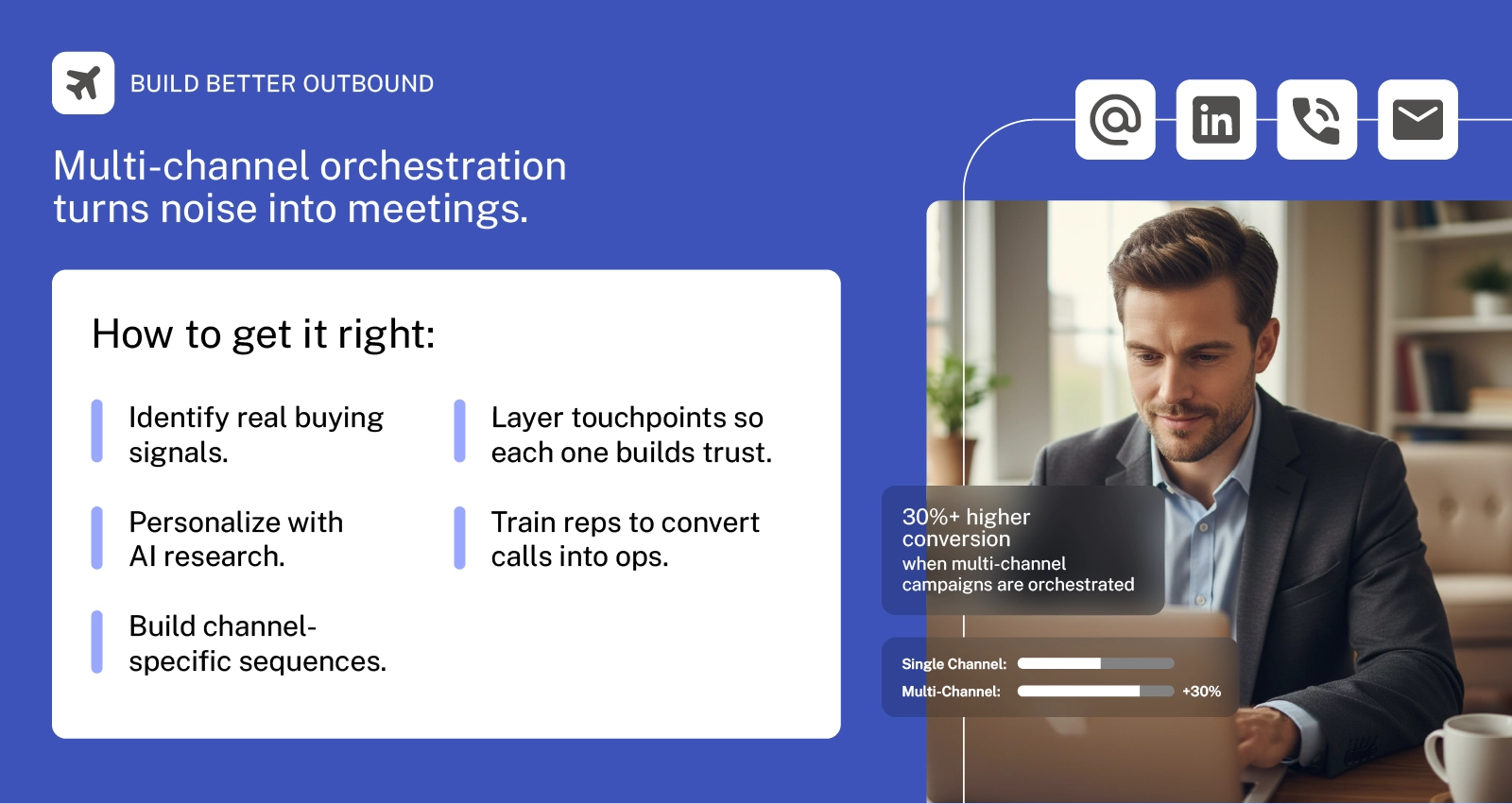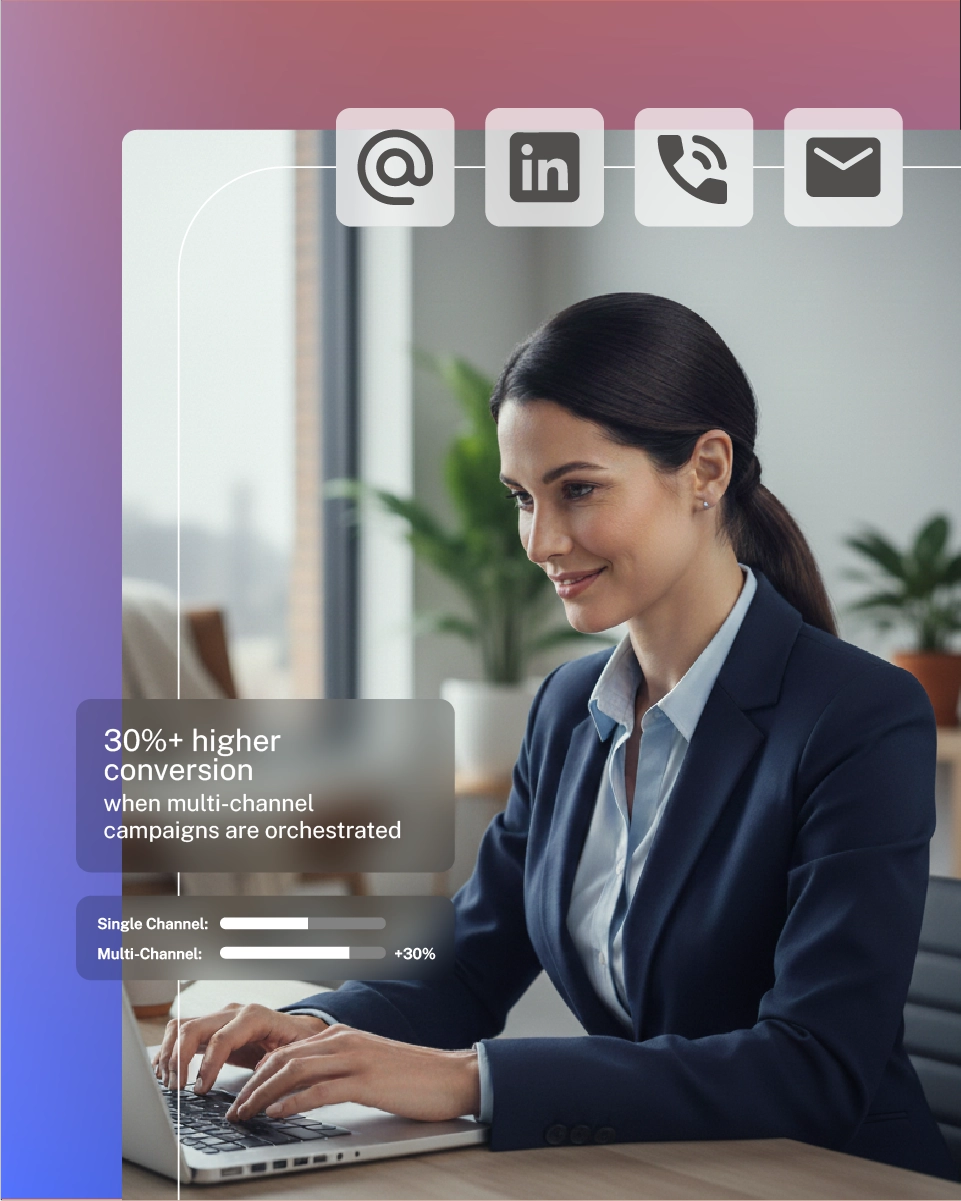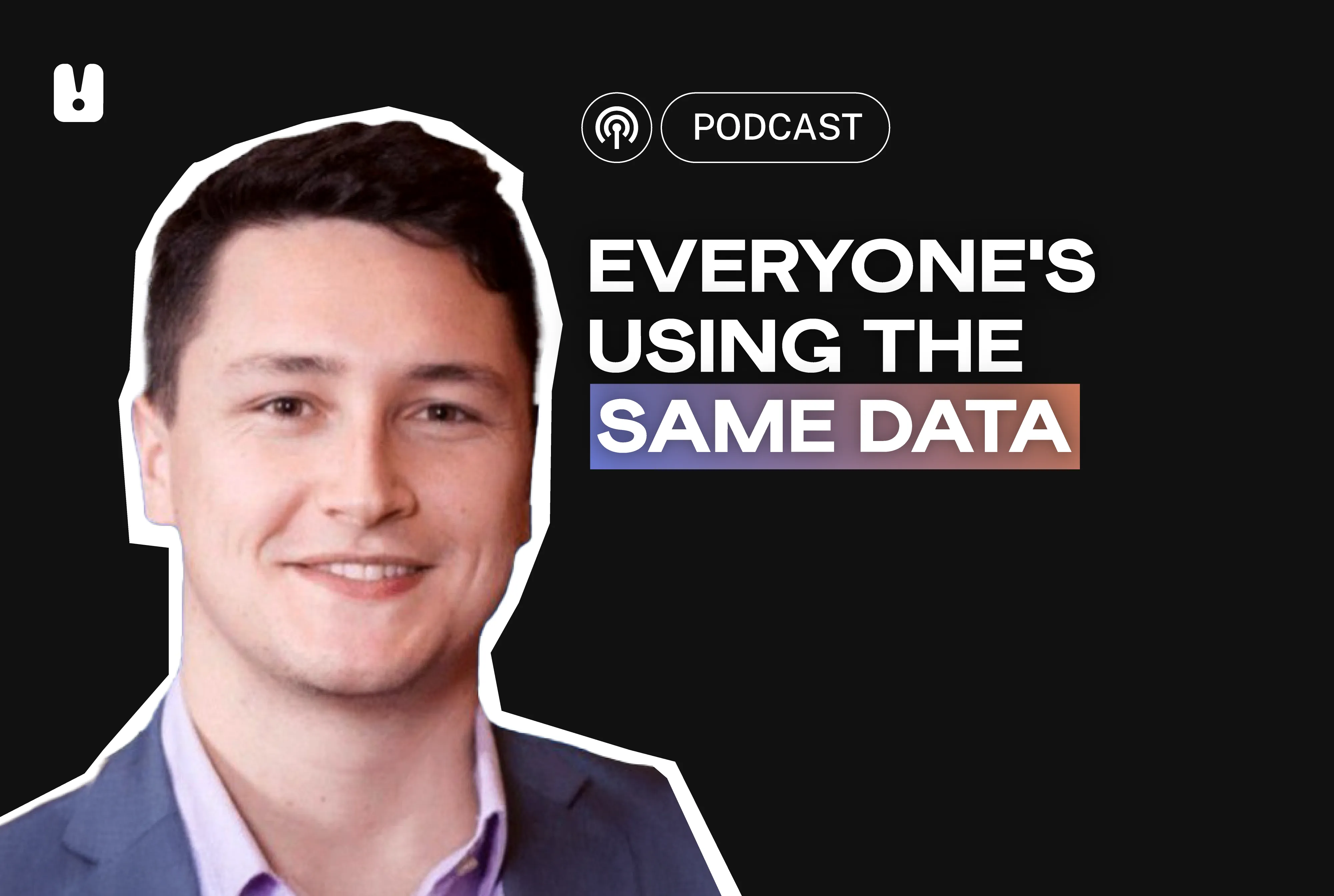

Designing Your B2B Outbound Sales Team for 2026 and Beyond
As we approach 2026, companies must rethink their team structures, embrace emerging technologies, and adapt to evolving buyer expectations to remain competitive.
The most successful organizations will be those that combine specialized expertise with AI-powered efficiency while maintaining the human touch that drives relationship-based selling.
The New Sales Development Hierarchy
The future belongs to intelligence specialists who combine market research with targeted outreach.
Sales Development Representatives
Modern SDRs should be:
- Signal hunters: Monitoring 50+ buying triggers across target accounts
- Market mappers: Understanding entire decision-making units, not just single contacts
- Competitive intelligence agents: Tracking competitor movements and market shifts
- Relationship orchestrators: Building multi-threaded connections across organization
I worked with a SaaS company that transformed their SDR role from "dialer" to "researcher." Instead of 100 calls per day, their SDRs focused on 20 deeply researched accounts.
Result? Their qualified opportunity rate jumped from 2% to 18% in four months.
Account Executives
AEs in 2026 won't be glorified appointment setters. They'll be conversion specialists who bridge the gap between awareness and interest.
Key capabilities include:
- Multi-channel orchestration: Coordinating touchpoints across phone, email, LinkedIn, video, and direct mail
- Behavioral psychology: Understanding what motivates different buyer personas
- Objection anticipation: Addressing concerns before they become roadblocks
- Value articulation: Translating features into business outcomes
The New Role: GTM Engineer
This position doesn't exist in most organizations yet. But it will be essential by 2026.
Think of them as the air traffic controllers of your outbound operation:
- Performance optimization: Continuous A/B testing of messaging, timing, and tactics
- Market intelligence coordination: Synthesizing insights across all campaigns
- Technology orchestration: Ensuring your MarTech stack works in harmony
- Predictive analytics: Forecasting pipeline health and identifying risks
Specialization vs. Hybrid
The eternal question: should you build specialized roles or hybrid generalists?
The answer depends on your deal complexity and team size.
When to Choose Specialization:
- High-value contracts (£50k+ annually)
- Complex sales cycles (3+ months)
- Multiple stakeholders (5+ decision makers)
- Technical products requiring deep expertise
I've seen this work brilliantly with enterprise software companies. One client specialized their team by vertical (healthcare, finance, manufacturing). Each SDR became an industry expert, speaking the language and understanding specific pain points. Their conversion rates doubled within six months.
When Hybrid Makes Sense:
- Lower contract values (Under £25k annually)
- Shorter sales cycles (Under 6 weeks)
- Smaller teams (Under 10 people)
- Resource constraints limiting hiring
A mid-market client successfully ran hybrid SDRs who could prospect, qualify, and even close smaller deals. It reduced handoff friction and improved customer experience.
But here's the key: even hybrid roles need primary specializations. Nobody excels at everything.
Why 68% of Companies Are Going External
Let me share a story that'll make you rethink everything.
Last year, I consulted with a growing fintech company. They'd been trying to build an in-house SDR team for 18 months. They'd burned through £300k in hiring, training, and tools.
Their pipeline? Practically non-existent.
Within 90 days of partnering with a specialized sales development agency, they generated £1.2M in qualified pipeline.
The difference? Instant access to proven methodologies, advanced technology, and experienced talent. We've written extensively about whether an outsourced sales agency is right for you, and the data shows this trend accelerating as companies recognize the strategic advantages.
The outsourced sales development market is exploding because smart companies recognize the advantages:
Immediate Expertise Access
Building internal expertise takes years. Buying it takes weeks.
When you outsource, you're not just hiring people – you're accessing:
- Proven methodologies refined across hundreds of campaigns
- Advanced technology stacks that would cost millions to build internally
- Industry expertise across multiple verticals and use cases
- Global talent pools operating across multiple time zones
Scalability Without Commitment
Need to ramp up for a product launch? Scale down during quiet periods? Outsourcing provides flexibility that internal teams can't match.
One client needed to test three new markets simultaneously. Instead of hiring 15 new SDRs (and risking massive layoffs if markets didn't work), they partnered with an agency.
Two markets failed, one succeeded. They scaled the winning market and avoided the costs of the failed ones.
Risk Mitigation
Bad hires cost 2.5X their annual salary when you factor in hiring costs, training, lost productivity, and severance. With outsourcing, performance risk transfers to the agency.
Plus, you avoid the overhead costs that kill profitability:
- Office space and equipment
- HR administration and payroll
- Training and development programs
- Technology licenses and support
- Management time and attention
AI Integration
Here's where most people get it wrong. Contrary to fear-mongering headlines, AI isn't coming for your sales job - it's making salespeople unstoppable by handling routine tasks and amplifying human capabilities.
By 2026, AI will handle the routine work that currently consumes 60% of an SDR's time:
Research and Prospecting
AI can analyze thousands of data points to identify high-probability prospects:
- Buying intent signals: Technology adoption, funding rounds, hiring patterns
- Behavioral indicators: Website engagement, content consumption, competitive research
- Timing triggers: Contract renewals, budget cycles, organizational changes
- Competitive intelligence: Market positioning, pricing changes, personnel moves
Personalization at Scale
Modern AI creates truly personalized outreach without sacrificing efficiency:
- Dynamic content generation based on prospect role, industry, and recent activities
- Multi-stakeholder messaging that coordinates across entire decision-making units
- Cross-channel consistency ensuring aligned messaging across all touchpoints
- Real-time optimization that adapts based on engagement patterns
Performance Optimization
AI continuously optimizes every aspect of your outbound operations:
- Send time optimization: Finding the perfect moment for each prospect
- Channel selection: Choosing the most effective touchpoint for each interaction
- Message testing: A/B testing at scale with statistical significance
- Conversion prediction: Identifying which prospects are most likely to convert
But here's the critical point: AI amplifies human capability. It doesn't replace human judgment, creativity, and relationship-building skills.
The "Multi-Everything" Strategy
Gone are the days of single-channel outreach. Modern buyers expect multi-touch, multi-channel experiences that provide value at every interaction.
The winning approach combines:
Multi-Threading
Engaging multiple stakeholders simultaneously across the decision-making unit.
Multi-Tactics
Phone calls, emails, LinkedIn messages, video messages, direct mail, and strategic gifting.
Multi-Channels
Professional networks, email systems, phone systems, social platforms, and offline channels.
Multi-Touch
6-10 touchpoints optimally spaced over 2-3 weeks, with each providing unique value.
I worked with a client who increased their response rate by 340% using multi-channel sequences. The key? Each touchpoint provided different value – market insights, case studies, tools, introductions – rather than just repeating the same pitch.
Remote and Hybrid Models
The future is distributed. By 2026, the best outbound teams will combine remote efficiency with strategic in-person interactions.
The Remote Advantages:
- 24/7 market coverage: Follow-the-sun operations for global prospects
- Access to global talent: Best people regardless of location
- Cost optimization: Avoiding geographic salary premiums
- Scalability: Rapid expansion without physical constraints
When to Go In-Person:
- Complex deal support: High-value opportunity progression
- Relationship building: Key stakeholder meetings
- Team training: Culture building and knowledge sharing
- Industry events: Market intelligence and networking
Making Remote Work:
The key is intentional culture building:
- Over-communication protocols: Preventing isolation and misalignment
- Outcome-based metrics: Focus on results, not activity
- Regular coaching: Weekly 1:1s and skill development
- Technology excellence: Professional presence across all digital channels
Performance Measurement
As we explored in our analysis of crucial KPIs to measure outbound success, most companies are tracking activity metrics rather than business impact - a fundamental flaw that becomes even more critical as we approach 2026
The New Performance Framework:
Primary Indicators:
- Pipeline velocity: Time from first touch to closed opportunity
- Conversion rate by stage: MQL to SQL to opportunity progression
- Revenue per team member: Monthly pipeline generation
- Customer acquisition cost: Total cost per qualified opportunity
Advanced Analytics:
- Multi-touch attribution: Understanding which touchpoints drive conversions
- Channel performance analysis: ROI by communication method
- Predictive pipeline forecasting: AI-powered revenue projections
- Competitive win/loss analysis: Market positioning insights
Quality Metrics:
- Conversation quality scores: AI-analyzed call effectiveness
- Relationship depth indicators: Multi-stakeholder engagement levels
- Value delivery metrics: Insights provided per interaction
- Customer satisfaction scores: Buyer experience ratings
The goal isn't just more activity. It's better outcomes through smarter execution.
Building for Scale: Your 2026 Action Plan
Ready to transform your outbound sales structure? Here's your blueprint:
Phase 1: Assessment
- Audit current team structure and performance
- Identify gaps in skills, technology, and processes
- Benchmark against industry best practices
- Define success metrics and goals
Phase 2: Technology Foundation
- Implement AI-powered prospecting tools
- Integrate multi-channel orchestration platforms
- Establish performance tracking and analytics
- Create data integration and workflow automation
Phase 3: Team Restructuring
- Redefine roles based on specialization strategy
- Implement training programs for new capabilities
- Establish coaching and development processes
- Create performance management frameworks
Phase 4: Optimization
- Continuous A/B testing of messages and processes
- Regular skill development and training updates
- Performance monitoring and improvement cycles
- Strategic planning and competitive analysis
The Future is Now: Your Competitive Advantage Awaits
The transformation of B2B outbound sales isn't coming – it's here. Companies that adapt quickly will capture disproportionate market share. Those that don't will struggle to compete.
The winning formula combines:
- Specialized expertise over generic activity
- AI amplification of human capabilities
- Multi-channel orchestration for modern buyers
- Continuous optimization based on performance data
- Global talent with local market expertise
The question isn't whether to evolve your outbound sales structure. It's how quickly you can make the transition.
Because while you're debating, your competitors are already building their 2026 advantage.
Ready to design your future-ready outbound sales team?
The blueprint is here. The technology exists. The talent is available.
The only question is: will you lead the transformation or follow it?
At Punch!, we've helped companies like AWS, Square, and DHL build outbound sales structures that dominate their markets. Our combination of specialized expertise, AI technology, and proven methodologies delivers the results your business needs to scale rapidly and profitably.



“I focus on leading the direction of the business to maximise team efficiency and ensure client success”
As we approach 2026, companies must rethink their team structures, embrace emerging technologies, and adapt to evolving buyer expectations to remain competitive.
The most successful organizations will be those that combine specialized expertise with AI-powered efficiency while maintaining the human touch that drives relationship-based selling.
The New Sales Development Hierarchy
The future belongs to intelligence specialists who combine market research with targeted outreach.
Sales Development Representatives
Modern SDRs should be:
- Signal hunters: Monitoring 50+ buying triggers across target accounts
- Market mappers: Understanding entire decision-making units, not just single contacts
- Competitive intelligence agents: Tracking competitor movements and market shifts
- Relationship orchestrators: Building multi-threaded connections across organization
I worked with a SaaS company that transformed their SDR role from "dialer" to "researcher." Instead of 100 calls per day, their SDRs focused on 20 deeply researched accounts.
Result? Their qualified opportunity rate jumped from 2% to 18% in four months.
Account Executives
AEs in 2026 won't be glorified appointment setters. They'll be conversion specialists who bridge the gap between awareness and interest.
Key capabilities include:
- Multi-channel orchestration: Coordinating touchpoints across phone, email, LinkedIn, video, and direct mail
- Behavioral psychology: Understanding what motivates different buyer personas
- Objection anticipation: Addressing concerns before they become roadblocks
- Value articulation: Translating features into business outcomes
The New Role: GTM Engineer
This position doesn't exist in most organizations yet. But it will be essential by 2026.
Think of them as the air traffic controllers of your outbound operation:
- Performance optimization: Continuous A/B testing of messaging, timing, and tactics
- Market intelligence coordination: Synthesizing insights across all campaigns
- Technology orchestration: Ensuring your MarTech stack works in harmony
- Predictive analytics: Forecasting pipeline health and identifying risks
Specialization vs. Hybrid
The eternal question: should you build specialized roles or hybrid generalists?
The answer depends on your deal complexity and team size.
When to Choose Specialization:
- High-value contracts (£50k+ annually)
- Complex sales cycles (3+ months)
- Multiple stakeholders (5+ decision makers)
- Technical products requiring deep expertise
I've seen this work brilliantly with enterprise software companies. One client specialized their team by vertical (healthcare, finance, manufacturing). Each SDR became an industry expert, speaking the language and understanding specific pain points. Their conversion rates doubled within six months.
When Hybrid Makes Sense:
- Lower contract values (Under £25k annually)
- Shorter sales cycles (Under 6 weeks)
- Smaller teams (Under 10 people)
- Resource constraints limiting hiring
A mid-market client successfully ran hybrid SDRs who could prospect, qualify, and even close smaller deals. It reduced handoff friction and improved customer experience.
But here's the key: even hybrid roles need primary specializations. Nobody excels at everything.
Why 68% of Companies Are Going External
Let me share a story that'll make you rethink everything.
Last year, I consulted with a growing fintech company. They'd been trying to build an in-house SDR team for 18 months. They'd burned through £300k in hiring, training, and tools.
Their pipeline? Practically non-existent.
Within 90 days of partnering with a specialized sales development agency, they generated £1.2M in qualified pipeline.
The difference? Instant access to proven methodologies, advanced technology, and experienced talent. We've written extensively about whether an outsourced sales agency is right for you, and the data shows this trend accelerating as companies recognize the strategic advantages.
The outsourced sales development market is exploding because smart companies recognize the advantages:
Immediate Expertise Access
Building internal expertise takes years. Buying it takes weeks.
When you outsource, you're not just hiring people – you're accessing:
- Proven methodologies refined across hundreds of campaigns
- Advanced technology stacks that would cost millions to build internally
- Industry expertise across multiple verticals and use cases
- Global talent pools operating across multiple time zones
Scalability Without Commitment
Need to ramp up for a product launch? Scale down during quiet periods? Outsourcing provides flexibility that internal teams can't match.
One client needed to test three new markets simultaneously. Instead of hiring 15 new SDRs (and risking massive layoffs if markets didn't work), they partnered with an agency.
Two markets failed, one succeeded. They scaled the winning market and avoided the costs of the failed ones.
Risk Mitigation
Bad hires cost 2.5X their annual salary when you factor in hiring costs, training, lost productivity, and severance. With outsourcing, performance risk transfers to the agency.
Plus, you avoid the overhead costs that kill profitability:
- Office space and equipment
- HR administration and payroll
- Training and development programs
- Technology licenses and support
- Management time and attention
AI Integration
Here's where most people get it wrong. Contrary to fear-mongering headlines, AI isn't coming for your sales job - it's making salespeople unstoppable by handling routine tasks and amplifying human capabilities.
By 2026, AI will handle the routine work that currently consumes 60% of an SDR's time:
Research and Prospecting
AI can analyze thousands of data points to identify high-probability prospects:
- Buying intent signals: Technology adoption, funding rounds, hiring patterns
- Behavioral indicators: Website engagement, content consumption, competitive research
- Timing triggers: Contract renewals, budget cycles, organizational changes
- Competitive intelligence: Market positioning, pricing changes, personnel moves
Personalization at Scale
Modern AI creates truly personalized outreach without sacrificing efficiency:
- Dynamic content generation based on prospect role, industry, and recent activities
- Multi-stakeholder messaging that coordinates across entire decision-making units
- Cross-channel consistency ensuring aligned messaging across all touchpoints
- Real-time optimization that adapts based on engagement patterns
Performance Optimization
AI continuously optimizes every aspect of your outbound operations:
- Send time optimization: Finding the perfect moment for each prospect
- Channel selection: Choosing the most effective touchpoint for each interaction
- Message testing: A/B testing at scale with statistical significance
- Conversion prediction: Identifying which prospects are most likely to convert
But here's the critical point: AI amplifies human capability. It doesn't replace human judgment, creativity, and relationship-building skills.
The "Multi-Everything" Strategy
Gone are the days of single-channel outreach. Modern buyers expect multi-touch, multi-channel experiences that provide value at every interaction.
The winning approach combines:
Multi-Threading
Engaging multiple stakeholders simultaneously across the decision-making unit.
Multi-Tactics
Phone calls, emails, LinkedIn messages, video messages, direct mail, and strategic gifting.
Multi-Channels
Professional networks, email systems, phone systems, social platforms, and offline channels.
Multi-Touch
6-10 touchpoints optimally spaced over 2-3 weeks, with each providing unique value.
I worked with a client who increased their response rate by 340% using multi-channel sequences. The key? Each touchpoint provided different value – market insights, case studies, tools, introductions – rather than just repeating the same pitch.
Remote and Hybrid Models
The future is distributed. By 2026, the best outbound teams will combine remote efficiency with strategic in-person interactions.
The Remote Advantages:
- 24/7 market coverage: Follow-the-sun operations for global prospects
- Access to global talent: Best people regardless of location
- Cost optimization: Avoiding geographic salary premiums
- Scalability: Rapid expansion without physical constraints
When to Go In-Person:
- Complex deal support: High-value opportunity progression
- Relationship building: Key stakeholder meetings
- Team training: Culture building and knowledge sharing
- Industry events: Market intelligence and networking
Making Remote Work:
The key is intentional culture building:
- Over-communication protocols: Preventing isolation and misalignment
- Outcome-based metrics: Focus on results, not activity
- Regular coaching: Weekly 1:1s and skill development
- Technology excellence: Professional presence across all digital channels
Performance Measurement
As we explored in our analysis of crucial KPIs to measure outbound success, most companies are tracking activity metrics rather than business impact - a fundamental flaw that becomes even more critical as we approach 2026
The New Performance Framework:
Primary Indicators:
- Pipeline velocity: Time from first touch to closed opportunity
- Conversion rate by stage: MQL to SQL to opportunity progression
- Revenue per team member: Monthly pipeline generation
- Customer acquisition cost: Total cost per qualified opportunity
Advanced Analytics:
- Multi-touch attribution: Understanding which touchpoints drive conversions
- Channel performance analysis: ROI by communication method
- Predictive pipeline forecasting: AI-powered revenue projections
- Competitive win/loss analysis: Market positioning insights
Quality Metrics:
- Conversation quality scores: AI-analyzed call effectiveness
- Relationship depth indicators: Multi-stakeholder engagement levels
- Value delivery metrics: Insights provided per interaction
- Customer satisfaction scores: Buyer experience ratings
The goal isn't just more activity. It's better outcomes through smarter execution.
Building for Scale: Your 2026 Action Plan
Ready to transform your outbound sales structure? Here's your blueprint:
Phase 1: Assessment
- Audit current team structure and performance
- Identify gaps in skills, technology, and processes
- Benchmark against industry best practices
- Define success metrics and goals
Phase 2: Technology Foundation
- Implement AI-powered prospecting tools
- Integrate multi-channel orchestration platforms
- Establish performance tracking and analytics
- Create data integration and workflow automation
Phase 3: Team Restructuring
- Redefine roles based on specialization strategy
- Implement training programs for new capabilities
- Establish coaching and development processes
- Create performance management frameworks
Phase 4: Optimization
- Continuous A/B testing of messages and processes
- Regular skill development and training updates
- Performance monitoring and improvement cycles
- Strategic planning and competitive analysis
The Future is Now: Your Competitive Advantage Awaits
The transformation of B2B outbound sales isn't coming – it's here. Companies that adapt quickly will capture disproportionate market share. Those that don't will struggle to compete.
The winning formula combines:
- Specialized expertise over generic activity
- AI amplification of human capabilities
- Multi-channel orchestration for modern buyers
- Continuous optimization based on performance data
- Global talent with local market expertise
The question isn't whether to evolve your outbound sales structure. It's how quickly you can make the transition.
Because while you're debating, your competitors are already building their 2026 advantage.
Ready to design your future-ready outbound sales team?
The blueprint is here. The technology exists. The talent is available.
The only question is: will you lead the transformation or follow it?
At Punch!, we've helped companies like AWS, Square, and DHL build outbound sales structures that dominate their markets. Our combination of specialized expertise, AI technology, and proven methodologies delivers the results your business needs to scale rapidly and profitably.














